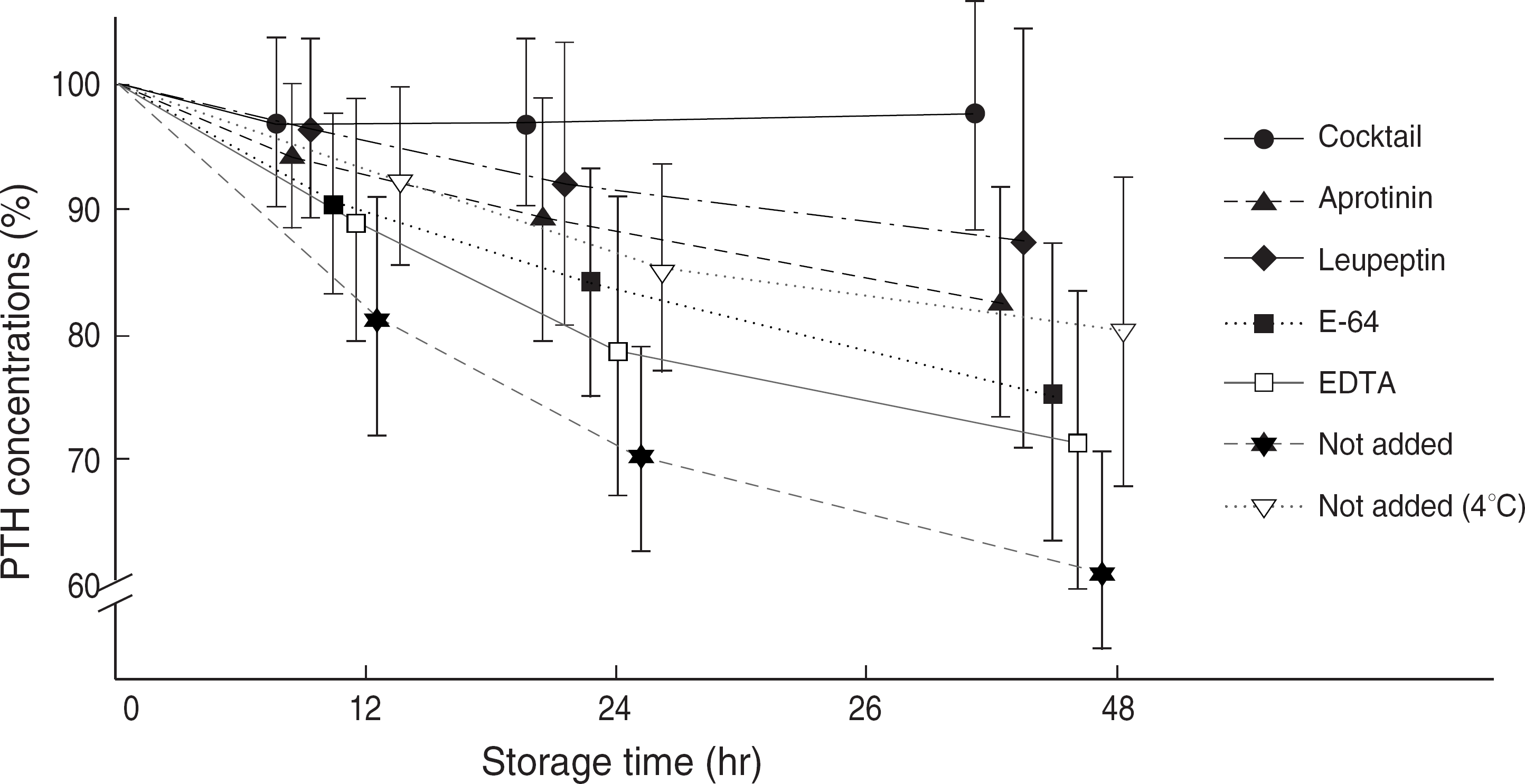Abstract
Background
The objective of this study was to evaluate the role of proteases on the degradation of parathyroid hormone (PTH) in blood samples.
Methods
Protease inhibitors with specificity against serine proteases (aprotinin), cysteine proteases (E-64), serine and cysteine proteases (leupeptin), metalloproteases (EDTA), or a protease inhibitor cocktail with a broad spectrum of inhibitory activity were added to blood samples. After storage at room temperature (0-48 hr), PTH levels were measured.
Results
PTH levels in samples with the protease inhibitor cocktail did not change significantly after 48 hr of storage at room temperature, but the average PTH levels decreased by 40.7% and 20.1%, in samples stored at room temperature and stored at 4°C without protease inhibitors, respectively. PTH levels in samples with leupeptin were stable for up to 24 hr. After 48 hr, the mean PTH levels decreased by 17.1%, 16.0%, 26.2%, and 32.1%, with 500 KIU/mL aprotinin, 100 μmol/L leupeptin, 10 μmol/L E-64, and 10 μmol/L EDTA, respectively, in the samples stored at room temperature.
Conclusions
The decrease in PTH levels in blood samples seemed to be due to the degradation of PTH by proteases. Various proteases, including especially serine proteases, would act together to degrade PTH in blood specimen. The PTH degradation may be inhibited in blood specimen with protease inhibitor cocktail.
Go to : 
REFERENCES
1.Endres DB., Rude RK. Mineral and bone metabolism. Burtis CA, Ashwood ER, editors. Tietz textbook of clinical chemistry and molecular diagnostics. 4th ed.Philadelphia: Elsevier Saunders;2006. p. 1891–965.
2.Juppner H., Gardella TJ, et al. Parathyroid hormone and parathyroid hormone-related peptide in the regulation of calcium homeostasis and bone development. DeGroot LJ, Jameson JL, editors. Endocrinology. 5th ed.Philadelphia: Elsevier Saunders;2006. p. 1377–417.
3.Levin GE., Nisbet JA. Stability of parathyroid hormone-related protein and parathyroid hormone at room temperature. Ann Clin Biochem. 1994. 31:497–500.

4.Russell D., Henley R. The stability of parathyroid hormone in blood and serum samples at 4 degrees C and at room temperature. Ann Clin Biochem. 1995. 32:216–7.
5.Evans MJ., Livesey JH., Ellis MJ., Yandle TG. Effect of anticoagulants and storage temperatures on stability of plasma and serum hormones. Clin Biochem. 2001. 34:107–12.

6.Gerhartz B., Niestroj AJ, et al. Enzyme classes and mechanisms. Smith HJ, Simon C, editors. Proteinase and peptidase inhibition: recent potential targets for drug development. London and New York: Taylor and Francis;2002. p. 1–20.
7.Garcia-Touchard A., Henry TD., Sangiorgi G., Spagnoli LG., Mauriello A., Conover C, et al. Extracellular proteases in atherosclerosis and restenosis. Arterioscler Thromb Vasc Biol. 2005. 25:1119–27.

8.Puente XS., Sanchez LM., Overall CM., Lopez-Otin C. Human and mouse proteases: a comparative genomic approach. Nat Rev Genet. 2003. 4:544–58.

9.Teal TK., Reed M., Stevens PE., Lamb EJ. Stability of parathyroid hormone ex vivo in haemodialysis patients. Ann Clin Biochem. 2003. 40:191–3.

10.National Committee for Clinical Laboratory Standards. Tubes and additives for venous blood specimen collection; approved standard, H1-A5. Wayne, PA: National Committee for Clinical Laboratory Standards;2003.
11.Auld DS. Removal and replacement of metal ions in metallopeptidases. Barrett AJ, editor. Proteolytic enzymes: aspartic and metal-lopeptidases. San Diego: Academic Press;1995. p. 228–42.
12.Anderson NR., Nicholas J., Holland MR., Gama R. Effect of a protease inhibitor on in vitro stability of intact parathyroid hormone. Ann Clin Biochem. 2003. 40:188–90.

13.English E., McFarlane I., Taylor KP., Halsall DJ. The effect of potassium EDTA on the stability of parathyroid hormone in whole blood. Ann Clin Biochem. 2007. 44:297–9.

14.Chi CW., Liu HZ., Liu CY., Chibber BA., Castellino FJ. The inhibition of the enzymic activity of blood coagulation and fibrinolytic serine proteases by a new leupeptin-like inhibitor, and its structural analogues, isolated from Streptomyces griseus. J Antibiot. 1989. 42:1506–12.
15.Rao GH., White JG., Cox CA. Influence a calcium dependent protease inhibitor on platelet activation and secretion. Thromb Res. 1987. 47:625–37.
Go to : 
 | Fig. 1.Time-dependent changes of the PTH levels in samples with different kinds of protease inhibitors. Data points are the mean ±SD (error bars) of PTH levels. Six groups of samples were stored at room temperature and the other group was stored at 4°C. Abbreviation: PTH, parathyroid hormone. |
Table 1.
Changes of PTH levels in blood specimen according to different storage conditions
| Storage condition | PTH levels (pg/mL)∗ | P† | |||
|---|---|---|---|---|---|
| Zero time | After 12 hr | After 24 hr | After 48 hr | ||
| Storage at room temperature | |||||
| Without protease inhibitors | 35.4±13.1 | 28.1±8.4 | 23.8±.4 | 21.0±6.2 | 0.005 |
| With protease inhibitors | |||||
| Inhibitor cocktail | 34.7±12.4 | 33.6±12.7 | 33.14±11.9 | 33.3±11.5 | 0.139 |
| Aprotinin, 500 KIU/mL | 35.6±12.6 | 33.5±11.8 | 31.8±12.7 | 29.5±11.0 | 0.005 |
| Leupeptin, 100 μmol/L | 45.0±9.0 | 43.6±15.9 | 41.9±15.7 | 37.8±14.2 | 0.028 |
| E-64, 10 μmol/L | 34.3±12.2 | 30.6±10.9 | 28.7±11.3 | 25.3±9.9 | 0.005 |
| EDTA, 10 μmol/L | 34.9±13.5 | 30.1±9.8 | 26.4±9.5 | 23.7±8.3 | 0.008 |
| Storage at 4°C | |||||
| Without protease inhibitors | 35.9±14.2 | 33.6±13.7 | 30.6±12.4 | 28.7±11.1 | 0.009 |




 PDF
PDF ePub
ePub Citation
Citation Print
Print


 XML Download
XML Download